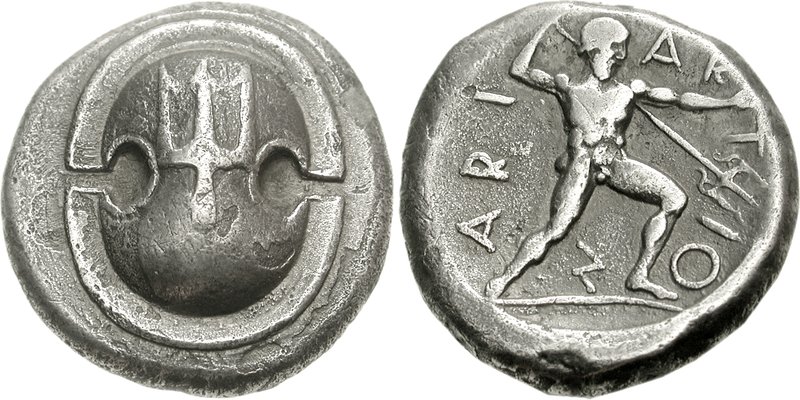Boeotian shield on:
[Wikipedia]
[Google]
[Amazon]
 A Boeotian shield is a large hand-held shield once carried by warriors in
A Boeotian shield is a large hand-held shield once carried by warriors in
 A Boeotian shield is a large hand-held shield once carried by warriors in
A Boeotian shield is a large hand-held shield once carried by warriors in Ancient Greece
Ancient Greece ( el, Ἑλλάς, Hellás) was a northeastern Mediterranean Sea, Mediterranean civilization, existing from the Greek Dark Ages of the 12th–9th centuries BC to the end of Classical Antiquity, classical antiquity ( AD 600), th ...
. It is similar to the more commonly encountered '' aspis'' in that it has an overall circular shape, but differed in having scooped indentations at both sides. The term "Boeotian" as applied to this armament is a modern construct resulting from its frequent appearance on ancient Boeotian coins. No shield of this type has physically survived into the modern era, but this type, along with the Boeotian helmet
The Boeotian helmet was a type of combat helmet used in Ancient Greece during the classical and Hellenistic periods, as well as in Ancient Rome; it possibly originated in the Greek region of Boeotia.
Characteristics
The Boeotian helmet was mod ...
, are considered characteristic of the warriors of Boeotia.
A Greek phalanx
The phalanx ( grc, φάλαγξ; plural phalanxes or phalanges, , ) was a rectangular mass military formation, usually composed entirely of heavy infantry armed with spears, pikes, sarissas, or similar pole weapons. The term is particularly ...
was a military unit whose performance was based in part on the relative uniformity of arms and armor of its principal members, the hoplites
Hoplites ( ) ( grc, ὁπλίτης : hoplítēs) were citizen-soldiers of Ancient Greek city-states who were primarily armed with spears and shields. Hoplite soldiers used the phalanx formation to be effective in war with fewer soldiers. The f ...
. This need for uniformity apparently extended to the shape of the groups' shields. The Boeotian shield was narrower and more oval than the circular ''aspis'', and on each of its vertical edges was a scooped indentation not unlike the C-bouts found on the waist of a modern violin and probably used for similar purpose: just as the violin's C-bouts allow the player to run the bow close to the center of the instrument, the Boeotian shield's indentations allowed its bearer to thrust and stab with his weapon(s) from a position closer to the shield's center rather than having to reach around or over the shield to strike. They also reduced the shield's overall weight somewhat, and as the shield was often the heaviest piece of equipment carried by a warrior, any reduction in its weight would have been welcome. It is also possible that the Boeotian shield was constructed out of animal hides stretched over a wicker frame rather than being made of solid wood and bronze like the ''aspis''— this would account for none from the ancient world having survived. Like the helmets worn by the Boeotians, this less-expensive method of construction would have been preferred by the hoplites of this region who were often less well off than their counterparts in other regions of greater Greece.
References
{{reflist Greek shields Ancient Greek military terminology Ancient Boeotia